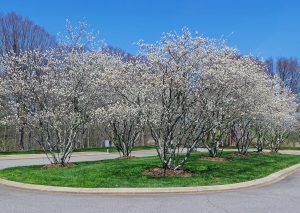
Serviceberry (Amelanchier spp.) is a small deciduous tree or shrub with attractive white spring blossoms, that provides year-round interest in the landscape, as well as producing edible fruits. Also called shadblow, shadbush, juneberry and saskatoon in different areas of the country, there are several different species that occur over most parts of the United States. There are 30 or so species of this genus in the pome-fruit subfamily of the Rose family (they are closely related to apples), with all but two native to North America. All have small, oval or elliptical leaves, with finely toothed margins and downy undersides.
Most Amelanchier species have showy but short-lived flowers produced in terminal clusters that may be upright or drooping. Each flower has five petals surrounding many stamens. The petals are generally white, but some cultivars can have pink to yellow petals. The flowers only last for about a week or less if it is warm or windy.

The flowers are followed by ¼ to ½-inch purple pome fruits with a waxy bloom that taste somewhat like blueberries when ripe. The fruits are ready for harvest 2 to 3 months after bloom.

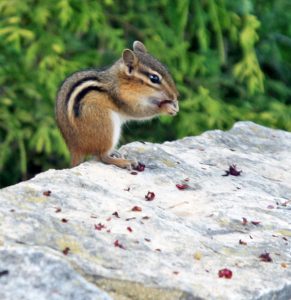
The tiny edible fruit are popular with birds, including American goldfinch, tufted titmice, brown thrashers, blue jays, Carolina chickadees, northern cardinals and American robins, and small animals. These fruits were also used by Native Americans and early settlers, and even today some species are cultivated as fruit trees, particularly in areas where other types of fruit trees do not do well. They can be used in jellies, cobblers, pies, muffins, coffee cakes or as dessert toppings. Fruit is produced 2 to 3 years after planting.
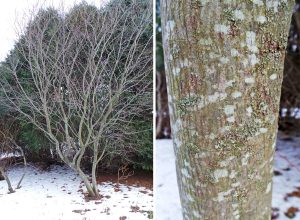
These graceful, airy trees or shrubs provide year-round ornamental interest in the landscape, with nice fall color ranging from yellow to red. Most species have interesting bark that provide winter interest, especially if the plant is pruned up as a tree rather than left as a multistemmed shrub.

Serviceberries can be naturalized at the edge of woodlands or used in many different ways in the landscape. They are equally useful as a specimen plant or in small groupings. They look particularly nice when planted against backdrop of darker foliage, such as evergreens, that allow the flowers, colorful fall foliage and grayish bark to stand out. They can also be used in shrub borders, as screens or as an unsheared hedge. The species native to boggy areas do well near water gardens.

Amelanchier are mainly woodland plants that prefer full sun to partial shade. They should be planted in rich, moist, well-drained soil. Serviceberries cast light shade and their roots aren’t invasive, so other plants, such as perennials that prefer partial shade, can easily be planted under them. They are prone to the same pests and diseases as apples and pears, including fireblight, and can serve as a host for cedar-quince rust, cedar-serviceberry rust, and cedar-hawthorn rust, which are caused by Gymnosporangium species.

There are several species that are commonly used as landscape plants. They are somewhat difficult to tell apart, since many look very similar and hybridize quite easily. Some species that are well suited to Wisconsin include:
Saskatoon or dwarf shadbush (A. alnifolia), is a multi-stemmed shrub or tree native to western North America, that grows to about 10 feet tall and spreads by rhizomes. Flowers appear in upright clusters after the leaves emerge in late spring to early summer. It produces lots of ½-inch, dark purple fruit, making it a good choice for attracting wildlife to your backyard. It is generally hardy in zones 3-9, but the cultivar ‘Altaglow’ is hardy to zone 1. ‘Regent’ is a smaller cultivar that forms clumps 3-6 feet tall and wide. Many cultivars, including ‘Honeywood’, ‘Northline’, ‘Pembina’, ‘Regent’ and ‘Smokey’, were selected for their their fruit quality rather than ornamental value.
Downy or Common serviceberry (A. arborea), also known as shadbush, is native to northeastern United States down through Florida and across to Iowa. This slow-growing small tree can eventually reach 15 to 25 feet tall. The drooping clusters of white flowers bloom in early spring. The common name downy refers to the leaves, which can be fuzzy when they first appear. The medium green leaves turn yellow-orange to red early in the fall. The small red fruits ripen in June, and are a favorite of birds. The smooth, gray bark is very ornamental, with vertical stripes. This species thrives in wet sites and is tolerant of pollution. It prefers moist, well-drained, acidic soil in full sun to partial shade. It is hardy to zone 4.
Eastern or Canadian serviceberry or shadbush (A. canadensis), is a upright suckering shrub or small tree that grows to 20 feet tall. Native to eastern North America, it occurs naturally in wet sites, bogs, and swamps. In early spring, the white flowers bloom in short, erect flower clusters. The new leaves are very wooly, but become hairless when mature, and turn gold in the fall. The juicy blue-black fruits. Many cultivars are available, including ‘Micropetala’, Rainbow Pillar®, Spring Glory® and Tradition®. Ornamental plantings are usually pruned up to form a small tree in order to show the striped, silver-gray bark. This species is hardy to zone 3.
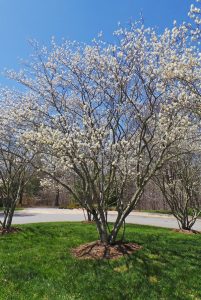
Apple serviceberry (A. ×grandiflora) is a hybrid of A. arborea and A. laevis, with an upright branching habit. It has the largest flowers of all serviceberries, and some types have pink flowers. It does not grow as tall as some of the other types and does particularly well in shade. There are a number of cultivars of apple serviceberry. ‘Autumn Brilliance’ offers red-orange foliage in the fall and resistance to diseases; ‘Ballerina’ is very spreading, up to 20 ft tall with bronze new leaves and masses of large flowers; ‘Robin Hill’ has pale pink flowers; ‘Rubescens’ has flowers flushed with pink, opening from darker pink buds. It is hardy in zones 4-9.
Smooth or Alleghany serviceberry (A. laevis) is a narrow, multistemmed shrub native to eastern North America that grows to 25 feet tall and 5 to 10 feet wide. The nodding or drooping white flower clusters bloom as the leaves unfold in late spring. The slightly downy, bronzy purple new leaves turn dark green in summer and turn yellow-orange to red early in the fall. The blue-black fruits are very sweet and juicy, and are a favorite of birds and other animals. The smooth, striped bark is a dull gray, while the slender stems are a reddish brown. This species is often pruned up to form small tree (but it does tend to sucker), and does best in full sun in wet sites. ‘Snowcloud’ has a columnar shape. other cultivars include ‘Cumulus’ and ‘Prince’ This species is hardy in zones 4-8.
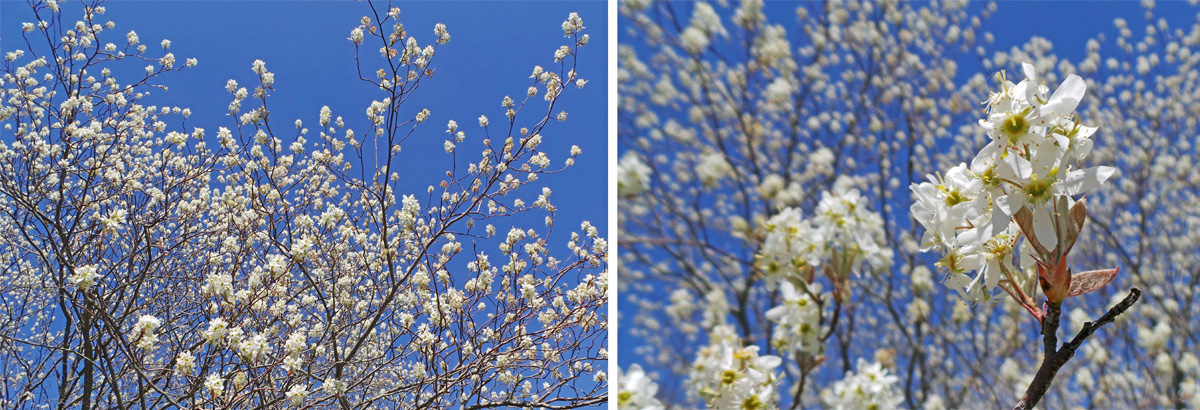
– Susan Mahr, University of Wisconsin – Madison
Latest from Wisconsin Yard & Garden
Ask Your Gardening Question
If you’re unable to find the information you need, please submit your gardening question here:





 Silver Leaf
Silver Leaf Red Star Rust
Red Star Rust Tree Species Recommended for Fall Planting
Tree Species Recommended for Fall Planting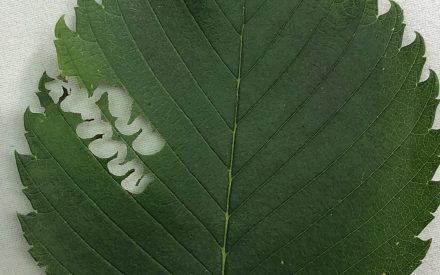 Elm Zigzag Sawfly
Elm Zigzag Sawfly


